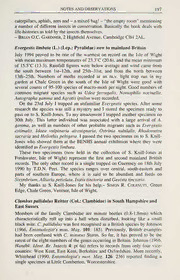
Evergestis limbatus (L.) (Lep.: Pyralidae) new to mainland Britain PDF
Preview Evergestis limbatus (L.) (Lep.: Pyralidae) new to mainland Britain
NOTES AND OBSERVATIONS 97 ] caterpillars, aphids, ants and - a mixed bag! - "the empty room" mentioning a number of different insects in conservation. Basically the book deals with life-histories as told by the insects themselves. - Brian O.C. Gardiner, 2 Highfield Avenue, Cambridge CB4 2AL. Evergestis limbata (L.) (Lep.: Pyralidae) new to mainland Britain July 1994 proved to be one of the warmest on record on the Isle of Wight with mean maximum temperatures of 23.3°C (20.6), and the mean minimum of 15.5°C (13.3). Rainfall figures were below average and wind came from the south between lst-12th, and 25th-31st, and from the north between 13th-25th. Numbers of moths recorded at an m.v. light trap run in my garden at Chale Green in the south of the Isle of Wight were good with several counts of 95-100 species of macro-moth per night. Good numbers of common migrant species such as Udea feirugalis, Nomophila noctuella, Autographa gamma andAgrotis ipsilon were recorded. On the 23rd July I trapped an unfamiliar Evergestis species. After some research the species was still a mystery and I stored the specimen ready to pass on to S. Knill-Jones. To my amazement I trapped another specimen on 30th July. This latter individual was associated with a large arrival of A. gamma, as well as numbers of other probable migrants such as Evergestis extimalis, Idaea vulpinaria atrosignaria, Ostrinia nuhilalis, Rhodometra sacraria and Heliothis peltigera. I passed the two specimens on to S. Knill- Jones who showed them at the BENHS annual exhibition where they were identified as Evergestis limbata. These two specimens (now held in the collection of S. Knill-Jones at Freshwater, Isle of Wight) represent the first and second mainland British records. The only other record is a single trapped on Guernsey on 18th July 1990 by T.D.N. Peet. The species ranges over central, south-eastern and parts of southern Europe, where it is said to be abundant and feeds on Sisymbrium, Alliariapetiolata, Isatis tinctoria and Genista tinctoria. My thanks to S. Knill-Jones for his help.- Simon R. Colenutt, Green Edge, Chale Green, Ventnor, Isle ofWight. Clambuspallidulus Reitter (Col.: Clambidae) in South Hampshire and East Sussex Members of the family Clambidae are minute beetles (0.8-1.8mm) which characteristically roll up into a ball when disturbed, looking like a small black mite. C. pallidulus was first recognised as a British species by Johnson (1966, Entomologist's mon. Mag. 101: 185). Previously, British examples had been confused with C. minutus Sturm. So far, it has proved to be the rarest ofthe eight members ofthe genus occurring in Britain. Johnson (1966, Handbk. Ident. Br. Insects 4: pt 6a) refers to records from only four vice- counties: West Kent, East Kent, Berkshire and Oxfordshire. More recently. Whitehead (1990, Entomologist's mon. Mag. 126: 236) reported finding a single specimen at Little Comberton, Worcestershire.
